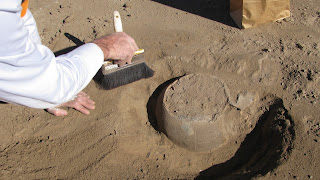In the morning, the backhoe uncovered a lizard, which had been hibernating in its underground home. I put it inside a paper sack and by the afternoon it was warm enough to start moving around. It sat in my palm for a few more minutes, before scurrying away to a safe place.
Lizard.
In the afternoon, we removed smelly dirt from the old driveway at the fort site, and beneath it we found a pit structure, perhaps 1,000-years-old.
The white paint line marks its approximate outline.
Burned posts ringed the edge of the house. Archaeologists like burned houses because they often contain the items that the people were unable to gather as they fled.
Burned posts.
The backhoe clipped an upside-down bowl in the center of the house. I had Allen uncover part of it to locate the floor level.
Tyler is mapping the site with the GPS device.
It looks like a plain ware bowl.
Close up of bowl.
After the environmental testing is completed, we will excavate a unit around the pot to collect more information about the house.
Lizard.
In the afternoon, we removed smelly dirt from the old driveway at the fort site, and beneath it we found a pit structure, perhaps 1,000-years-old.
The white paint line marks its approximate outline.
Burned posts ringed the edge of the house. Archaeologists like burned houses because they often contain the items that the people were unable to gather as they fled.
Burned posts.
The backhoe clipped an upside-down bowl in the center of the house. I had Allen uncover part of it to locate the floor level.
Tyler is mapping the site with the GPS device.
It looks like a plain ware bowl.
After the environmental testing is completed, we will excavate a unit around the pot to collect more information about the house.




